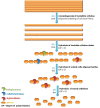Access to cellulose limits the efficiency of enzymatic hydrolysis: the role of amorphogenesis
- PMID: 20178562
- PMCID: PMC2844368
- DOI: 10.1186/1754-6834-3-4
Access to cellulose limits the efficiency of enzymatic hydrolysis: the role of amorphogenesis
Abstract
The efficient enzymatic saccharification of cellulose at low cellulase (protein) loadings continues to be a challenge for commercialization of a process for bioconversion of lignocellulose to ethanol. Currently, effective pretreatment followed by high enzyme loading is needed to overcome several substrate and enzyme factors that limit rapid and complete hydrolysis of the cellulosic fraction of biomass substrates. One of the major barriers faced by cellulase enzymes is their limited access to much of the cellulose that is buried within the highly ordered and tightly packed fibrillar architecture of the cellulose microfibrils. Rather than a sequential 'shaving' or 'planing' of the cellulose fibrils from the outside, it has been suggested that these inaccessible regions are disrupted or loosened by non-hydrolytic proteins, thereby increasing the cellulose surface area and making it more accessible to the cellulase enzyme complex. This initial stage in enzymatic saccharification of cellulose has been termed amorphogenesis. In this review, we describe the various amorphogenesis-inducing agents that have been suggested, and their possible role in enhancing the enzymatic hydrolysis of cellulose.
Figures


References
-
- Walker LP, Wilson DB. Enzymatic hydrolysis of cellulose: An Overview. Biores Technol. 1991;36:3–14. doi: 10.1016/0960-8524(91)90095-2. - DOI
-
- Xia L, Len P. Cellulose production by solid-state fermentation on lignocellulosic waste from the xylose industry. Process Biochem. 1999;34:909–912. doi: 10.1016/S0032-9592(99)00015-1. - DOI
LinkOut - more resources
Full Text Sources
Other Literature Sources

